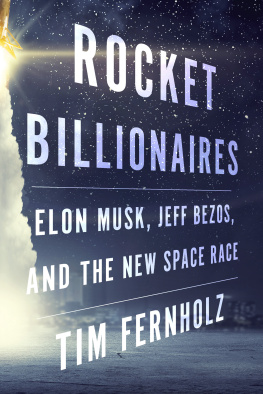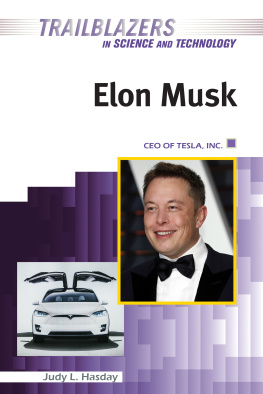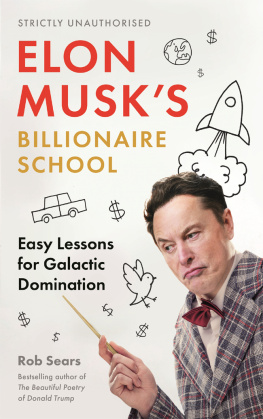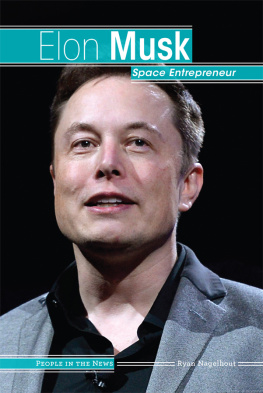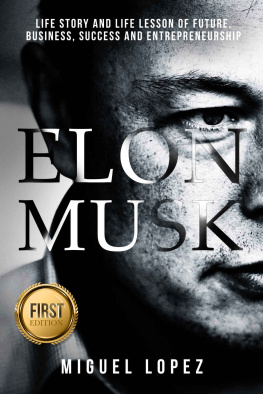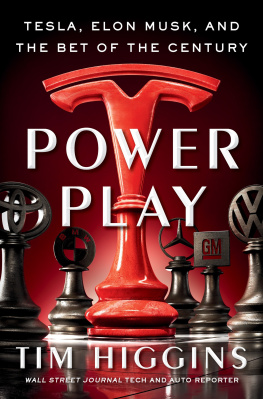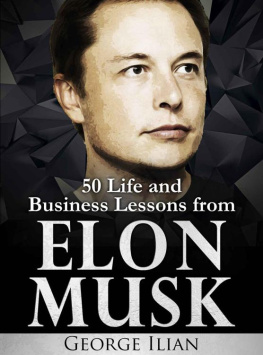Tim Fernholz - Rocket Billionaires: Elon Musk, Jeff Bezos, and the New Space Race
Here you can read online Tim Fernholz - Rocket Billionaires: Elon Musk, Jeff Bezos, and the New Space Race full text of the book (entire story) in english for free. Download pdf and epub, get meaning, cover and reviews about this ebook. year: 2018, publisher: Mariner Books, genre: Art. Description of the work, (preface) as well as reviews are available. Best literature library LitArk.com created for fans of good reading and offers a wide selection of genres:
Romance novel
Science fiction
Adventure
Detective
Science
History
Home and family
Prose
Art
Politics
Computer
Non-fiction
Religion
Business
Children
Humor
Choose a favorite category and find really read worthwhile books. Enjoy immersion in the world of imagination, feel the emotions of the characters or learn something new for yourself, make an fascinating discovery.
- Book:Rocket Billionaires: Elon Musk, Jeff Bezos, and the New Space Race
- Author:
- Publisher:Mariner Books
- Genre:
- Year:2018
- Rating:5 / 5
- Favourites:Add to favourites
- Your mark:
- 100
- 1
- 2
- 3
- 4
- 5
Rocket Billionaires: Elon Musk, Jeff Bezos, and the New Space Race: summary, description and annotation
We offer to read an annotation, description, summary or preface (depends on what the author of the book "Rocket Billionaires: Elon Musk, Jeff Bezos, and the New Space Race" wrote himself). If you haven't found the necessary information about the book — write in the comments, we will try to find it.
Tim Fernholz: author's other books
Who wrote Rocket Billionaires: Elon Musk, Jeff Bezos, and the New Space Race? Find out the surname, the name of the author of the book and a list of all author's works by series.
Rocket Billionaires: Elon Musk, Jeff Bezos, and the New Space Race — read online for free the complete book (whole text) full work
Below is the text of the book, divided by pages. System saving the place of the last page read, allows you to conveniently read the book "Rocket Billionaires: Elon Musk, Jeff Bezos, and the New Space Race" online for free, without having to search again every time where you left off. Put a bookmark, and you can go to the page where you finished reading at any time.
Font size:
Interval:
Bookmark:
Copyright 2018 by Tim Fernholz
All rights reserved
For information about permission to reproduce selections from this book, write to or to Permissions, Houghton Mifflin Harcourt Publishing Company, 3 Park Avenue, 19th Floor, New York, New York 10016.
hmhco.com
Library of Congress Cataloging-in-Publication Data is available.
ISBN 978-1-328-66223-1 (hardcover) ISBN 978-1-328-66306-1 (ebook)
Cover design by Brian Moore
Cover image Sergey Nivens / Shutterstock
v1.0218
For Rene
The rocket crowd has been going to the same swamp in Florida for years.
A triangular headland along the Atlantic coast, battered by hurricanes, Cape Canaveral might have become just another dubious land development scheme, a way to get out-of-state GIs to buy vacation homes in a swamp now that World War II was over. But serious men with slide rules got to it firstthey examined maps of the United States for real estate where they could hurl large machines full of explosives out over the ocean, in case they came back down again at distressing speed, and near enough to the equator that the earths spin would help the hurling. They liked the Cape just fine.
That was more than a half century ago. The Florida wetlands were filled in with concrete foundations for the American effort to leave earth and to travel the empty space around the planet and its nearby moon: first Mercury, then Gemini, and finally Apollo. As space became less the realm of the gods and more amenable to man, bureaucracy replaced divinity: Skylab, and then the space shuttle. The National Aeronautics and Space Administration (NASA) had, in 1958, begun life as an ad hoc assembly that included former Nazis, corn-fed American engineers, and brave test pilots racing the Soviets. It became a baroque institution focused primarily on building and maintaining the most expensive contraption constructed in human history: the International Space Station (ISS), a research outpost in orbit.
The US victory in the first international space race inspired awe: the sheer quantities of money and brainpower and science, all bending physics to the purpose of putting fragile mankind in a place where he did not belong. After the Apollo program, the ambitious space program gave way to a kind of complacency. There was a nagging sense that what the United States had done in going to the moon wasnt about what those pioneers had achieved, but what it had meant to those watching. NASA amounted to a sophisticated Cold War propaganda operation. Once it had demonstrated the ability to go to the moon, there was no obvious reason to go back. Presidents paid lip service to space exploration, but most who persisted in casting their eye toward the stars were seen as nostalgists.
Enter Elon Musk, the founder and CEO of Space Exploration Technologies Corporation. He also enjoys the title chief designer, and is clearly not a nostalgist, especially by the standards of rocket nerds. The intense South Africaborn entrepreneur started SpaceX, as it is called, so he could retire on Mars. On this day, his company was giving him a forty-fourth birthday present: it would launch a rocket into orbit and, for the first time in history, return it safely to earth.
Space Launch Complex 40 (SLC-40) at Cape Canaveral is heavy with historytoo much of it in the form of accumulated rules, habits, and conventional wisdom, in Musks opinion. Musks engineers had refurbished the old Air Force launchpad to operate efficiently, scavenging gear to move quickly and cheaply. They were now building a new private spaceport in Texas. But the realities of the space business demanded that SpaceX fly its rockets from the Cape, far from where they were built and tested, on a launchpad leased from the government. The plain truth was that the government didnt even have its own rockets anymore. That was SpaceXs business now.
On June 28, 2015, with launch in half an hour, a Falcon 9 rocket built by SpaceX stood on that pad. It was 230 feet tall and thirteen feet in diameter. The area was clear of people so that Musks creation could be fed thousands of pounds of liquid oxygen and high-test kerosene. The superchilled fluid flowing through the machine caused the sticky Florida air to condense; great bursts of steam made the rocket appear to breathe smoke, befitting the name of the spacecraft on topthe Dragon. Like a can of soda, most of a rockets launch mass is fluid, but comparing an aluminum rocket to a can of Coca-Cola does the rocket a disservice: its walls are far, far thinner, relatively speaking, than those on a beverage container. And, in order to fit even more propellant into the rocket, it would be chilled to as low as minus 340 degrees Fahrenheit.
In the control room at SpaceX headquarters, young controllers monitored pressure gauges, telemetry feeds, and cameras affixed all over the vehicle, even inside propellant tanks. Engineers participated in the companys live online stream of the launch, explaining the basics of the flight to the hundreds of thousands of fans and curiosity seekers tuning in to watch. Back in Florida, NASA officials, Air Force officers, and SpaceXs operations team all watched the countdown from behind computer consoles.
Were the government officials envious of the companys capabilities? Musks were the first privately owned spacecraft to fly a NASA mission to the International Space Station. To be sure, SpaceX had needed the space agencys funding and advice. But Musk insisted the rocket be designed according to his own principles, and each part of the tall white vehicle belonged to his companys shareholders. This was not a mere technicality; it was a revolutionary approach to spaceflight. And it was necessary for Musks broader ambitions of making humans into a multiplanetary civilization. Musk hadnt spent $100 million of his own money and the past thirteen years of his life simply to accomplish todays mission: carrying four thousand poundsa mass you could move with a Dodge Ram trucka few hundred milesthe distance between New York City and Boston. A trivial job, until you realize that youre moving those two tons straight up.
While the rocket prepared for launch, three astronauts were on board the ISS, 250 miles above the earth. They live in a series of aluminum tubes bolted together, circling our planet at great speed. Keeping them alive required regular visits from spacecraft carrying food, water, and oxygen, as well as the scientific apparatus and experiments that provided the justification for their improbable presence in space. Since constructing the station, in concert with international partnerschiefly Russia and the European UnionNASA had been forced to retire its only means of reaching it. In 2011, the space shuttle had been shut down for being too costly and dangerous to fly. Now the US space program, founded quite literally to demonstrate superiority over Russia, could not reach its most expensive scientific installation without Russian aid.
NASA had attempted to replace the space shuttle with several alternatives. Despite spending billions of dollarsmostly funneled to the shareholders of giant aerospace corporationsit had no new answers. After Barack Obama became president, his administration took an ax to the latest overbudget, delayed scheme to build a new rocket and space capsule. Let the space agency worry about the rest of the solar system. To keep the ISS operational, Obamas team would build on a George W. Bushera program that envisioned privatizing transit between earth and the space station.
This was the opportunity that Musk and his nascent space company had desperately needed. Tinkerers at the time, they had blown up more rockets than they had flown. Many considered Musk just another wealthy fool from Silicon Valley with a space bug. A decade before, Microsoft founder Bill Gates had invested millions in plans for an ambitious network of satellites, called a constellation, that people would use to connect to the internet. It ended in bankruptcy. The major space contractors, like Boeing, Lockheed Martin, and Northrop Grumman, armies of engineers with decades of practice, scoffed at the idea that youthful companies backed by software engineers might be up to the challenge of space travel.
Next pageFont size:
Interval:
Bookmark:
Similar books «Rocket Billionaires: Elon Musk, Jeff Bezos, and the New Space Race»
Look at similar books to Rocket Billionaires: Elon Musk, Jeff Bezos, and the New Space Race. We have selected literature similar in name and meaning in the hope of providing readers with more options to find new, interesting, not yet read works.
Discussion, reviews of the book Rocket Billionaires: Elon Musk, Jeff Bezos, and the New Space Race and just readers' own opinions. Leave your comments, write what you think about the work, its meaning or the main characters. Specify what exactly you liked and what you didn't like, and why you think so.

